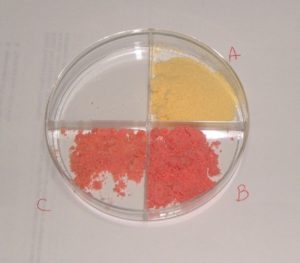Represented in the photograph are three samples of Vanderzant vitamins, A and B obtained from a different supplier, C being from the same batch as B but having been stored at room conditions for two weeks. In neither product was the reference cited as to which mixture was being used, but the most widely used formulation is that of Vanderzant (1973), cited below. The formulation of that mixture is provided in the table below.
However, it remains problematic for me to reconcile how two mixtures with identical names (“Vanderzant vitamins”) can be so dramatically different in appearance—one being obviously reddish-pink the other being conspicuously yellow! I am refraining from citing the sources of the vitamins, but I must point out that in the formulations that I have published, I have always used the pink mixture (e.g. Cohen 2000, 2003, 2015), and recently I have become aware that the yellow version existed. The pink to red color of the vitamin mix can be attributed to the color of vitamin B12, which contains the element cobalt. Something that is not entirely clear to me is the basis of the red/pink/yellow colored alternatives, but it raises questions for me as to whether the two vitamin mixes are fully equivalent.
As a possible explanation for the color differences, please consider the following: there are several forms of what is called B12 or cobalamin and one of the alternately-used forms of B12 Cyanocobalamin is frequently used in vitamin supplements because of its superior stability over the simple cobalamin form. In an internet article about B12 ( https://en.wikipedia.org/wiki/Cyanocobalamin) it is mentioned that various reduced forms of Cyanocobalamin, with cobalt present as Co(I), Co(II), or Co(III) appear nearly colorless for Co(I), yellowish for Co(II) and pink for Co(III).
I have posted here two comparisons of profiles of formulations that I found in an internet search of the term, “Vanderzant vitamins.” The 3rd formulation (not pictured here) represents itself as a modification, and two conspicuous differences are in the content of vitamin E or alpha-tocopherol and in the type of sugar used (sucrose, instead of glucose). One further point that bears thinking is the faded appearance of sample C in Figure 1. The vitamins in C are from the same batch as B, except that the materials in C were stored at room temperature and with light exposure for two weeks. How much does the color change reflect deterioration of potency or quality of the vitamins?
The natural question raised by these conspicuous differences is how much can we rely on the equivalency of each formulation? It is logical and reasonable to assume that any deviations from a prescribed, tested formulation can lead to differences in the performance of our target insects; and experience teaches us that very often differences often lead to harmful or undesirable results. I frequently tell my students that any changes in the rearing setting may be 1) harmful, 2) helpful, or 3) neutral, and the only way to tell which way these changes will affect our target insects is by empirical tests—side-by-side controlled experiments with the questionable variable and the standard (control) form rigorously compared.
Here are the stated compositions of two mixtures called “Vanderzant vitamins:”
Table 1.Vanderzant Vitamin Mixture
| Vitamin | Amount (g/kg) |
| alpha-tocopherol | 8 |
| Ascorbic acid | 270 |
| Biotin | 0.02 |
| Calcium pantothenate | 1 |
| Choline chloride | 50 |
| Crystalline folic acid | 0.25 |
| Inositol | 20 |
| Niacinamide | 1 |
| Pyridoxine hydrochloride | 0.25 |
| Riboflavin | 0.50 |
| Thiamine hydrochloride | 0.25 |
| Vitamin B12 trituration in mannitol | 2 |
| Q.S. with glucose | ~646.73 |
- Q.S. (Latin quantum sufficit): literally as much as will suffice, used when adding a filler to a mixture to bring the weight or volume up to a prescribed level
- Trituration: process of pulverizing a substance such as with a mortar and pestle, often used in diets as a means of mixing two or more solids such as a vitamin present in low concentrations with a sugar present in much higher concentrations
Vanderzant, E. S. 1973. Axenic rearing of larvae and adults of the boll weevils on defined diets: additional tests with amino acids and vitamins. Ann. Entomol. Soc. Am. 66: 1184-1186.
Cohen, A. C. 2000. New oligidic production diet for Lygus hesperus Knight and L. lineolaris (Palisot de Beauvois). J. Entomol. Sci. 35: 301-310.
Cohen, A. C. 2003. Artificial diet for arthropods (continuation in part). U.S. Patent 6,506,597. January 14, 2003.
Cohen, A. C. 2015. Insect Diets: Science and Technology. 2nd Edition. CRC Press. Boca Raton, Fl.
Table 2. Vanderzant formulation listed as “modified Vanderzant vitamins.”
| Ingredient | grams/kilogram |
| Sucrose | 638.73 |
| Vitamin E (500 IU/g) | 16.00 |
| Ascorbic Acid | 270.00 |
| Biotin | 0.02 |
| Calcium Pantothenate | 1.00 |
| Choline Chloride | 50.00 |
| Folic Acid | 0.25 |
| Inositol | 20.00 |
| Niacinamide | 1.0 |
| Pyridoxine HCl | 0.25 |
| Riboflavin | 0.50 |
| Thiamin HCl | 0.25 |
| Vitamin B12 (0.1%) | 2.00 |

